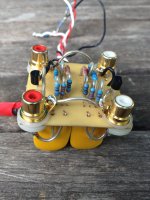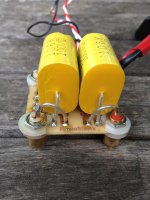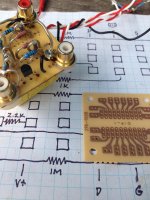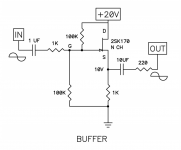If I may ask - was the solution in the param settings, the model, or something I'm not clever enough to work out?
second question - I see you noted a Beta parameter change. I have no idea how to alter a jfet model to a different idss/Vp setting. is that the solution?
It was the parameters of the simulation that created the change. They forced greater resolution in the simulation run. It takes about 4x as long to perform the new simulation with the improved parameters. Changing the model for the JFET causes almost no change in the output since degenerative feedback dominates the response of the 2SJ170
You can copy the parameters and apply them to any simulation and it will create a better result.
.tran 0 100m 0 0.1u
.OPTIONS numdgt=7.
.fourier 1K 4 V(Out)
Shoog
Last edited:
Thanks Shoog! It helped out my simulations as well. I'm using the JFET BOZ with a JFET B1 style buffer to make a headphone amp and have been wondering why my sims didn't look as good as predicted.
Just a quick note - i got the jboz up and running using a j310, and it sounds great. I spent a lovely day listening to it combined with an ACA through my Abby clones.
No fancy parts at all, power supply is using a random ac plugpack, and a pass mosfet and RC filtering, and the output caps were a (physically) massive set of 6.8uf x2 caps I happened to have on hand. Great result for basically zero dollars spent 🙂
No fancy parts at all, power supply is using a random ac plugpack, and a pass mosfet and RC filtering, and the output caps were a (physically) massive set of 6.8uf x2 caps I happened to have on hand. Great result for basically zero dollars spent 🙂
Howdy, Here's my Jfet Boz
I posted these pics on "Pictures of your Pass Amp", but they belong here. What fun building this has been. Just listened to it with a nice regulated supply (18v) into F5. Sounds great. Built per schematic on page 1, with 1.8K between V+ and drain to achieve 9V between drain and ground.
I posted these pics on "Pictures of your Pass Amp", but they belong here. What fun building this has been. Just listened to it with a nice regulated supply (18v) into F5. Sounds great. Built per schematic on page 1, with 1.8K between V+ and drain to achieve 9V between drain and ground.
Attachments
Hi, first post...
I'm interested in making a small ~integrated amp using a TPA3116D2 class D amplifier board with a simple preamp with volume, balance and input switching to make it convenient but also trying to minimize any harm to the signal.
The first part I ordered is a NOS Centralab PA-4002 2 pole, 23 position shorting rotary switch to make a series style stepped attenuator as used by W. Marshall Leach Jr. back in the day. I haven't ordered resistors yet.
I intend to use the Rod Elliot "centre weighted" balance control with a less exotic linear rule pot instead of a stepped attenuator and maybe Rod's potentiometer law changing resistor trick so that I can make the volume attenuator linear taper with common value resistors for a volume price break.
The main source component will be a HiFiMeDIY Sabre 9023 based DAC which has a 2 volt RMS output but is said to drop to 1 volt RMS when driving a 32 ohm headphone load. I don't know how that translates to output impedance. The second source will be the line out from my AV receiver. The third has no plans yet but I'm not entirely ruling out a turntable.
The amplifier has its gain and input impedance set by resistors. I think I need minimum gain which looks like +20 dB and 60k ohm. Of course as gain is increased input impedance decreases.
I intend to drive 8 ohm speakers with about 89dB sensitivity at reasonable levels in a room of less than 500 ft² or about 5,000 ft³ or 145 m³.
And now the question:
I've never been good with logarithms so I'm not sure how much gain I need between the DAC and the amp and what resistance value I need in the stepped attenuator.
I know I don't want clipping and the amp makes about 40 watts with low distortion in to an 8 ohm load. I also don't want to attenuate the signal more than necessary because the preamp gain is too high.
With that said, how much gain is right for me?
Should I build jfet BOZ or B1?
If I need some gain but not in the normal jfet BOZ range, what jfet and resistors should I use to get there?
I will have a ~24v supply in the case and don't mind adding a LDO for the preamp.
Luckily years ago on a lark I bought a Sound Technology 1700B distortion analyzer.
Unluckily I have no idea how to use it.
I have access to a pretty nice lab with variable power supplies, an old oscilloscope that I'm also unfamiliar with, good soldering irons and Fluke VOMs.
Any way when I have a plan that's a little more baked I'll buy parts, match up jfets and breadboard the circuit to dial in the component values
Thanks for the help if anyone wants to tackle all that.
I'm interested in making a small ~integrated amp using a TPA3116D2 class D amplifier board with a simple preamp with volume, balance and input switching to make it convenient but also trying to minimize any harm to the signal.
The first part I ordered is a NOS Centralab PA-4002 2 pole, 23 position shorting rotary switch to make a series style stepped attenuator as used by W. Marshall Leach Jr. back in the day. I haven't ordered resistors yet.
I intend to use the Rod Elliot "centre weighted" balance control with a less exotic linear rule pot instead of a stepped attenuator and maybe Rod's potentiometer law changing resistor trick so that I can make the volume attenuator linear taper with common value resistors for a volume price break.
The main source component will be a HiFiMeDIY Sabre 9023 based DAC which has a 2 volt RMS output but is said to drop to 1 volt RMS when driving a 32 ohm headphone load. I don't know how that translates to output impedance. The second source will be the line out from my AV receiver. The third has no plans yet but I'm not entirely ruling out a turntable.
The amplifier has its gain and input impedance set by resistors. I think I need minimum gain which looks like +20 dB and 60k ohm. Of course as gain is increased input impedance decreases.
I intend to drive 8 ohm speakers with about 89dB sensitivity at reasonable levels in a room of less than 500 ft² or about 5,000 ft³ or 145 m³.
And now the question:
I've never been good with logarithms so I'm not sure how much gain I need between the DAC and the amp and what resistance value I need in the stepped attenuator.
I know I don't want clipping and the amp makes about 40 watts with low distortion in to an 8 ohm load. I also don't want to attenuate the signal more than necessary because the preamp gain is too high.
With that said, how much gain is right for me?
Should I build jfet BOZ or B1?
If I need some gain but not in the normal jfet BOZ range, what jfet and resistors should I use to get there?
I will have a ~24v supply in the case and don't mind adding a LDO for the preamp.
Luckily years ago on a lark I bought a Sound Technology 1700B distortion analyzer.
Unluckily I have no idea how to use it.
I have access to a pretty nice lab with variable power supplies, an old oscilloscope that I'm also unfamiliar with, good soldering irons and Fluke VOMs.
Any way when I have a plan that's a little more baked I'll buy parts, match up jfets and breadboard the circuit to dial in the component values
Thanks for the help if anyone wants to tackle all that.
On another note. I recently bypasssed the boz-j 10uF caps with more "exotic" caps with very good results. Highly recommended.
I think the B1 will be enough. I used a passive pre into a tube buffer in front of a TK2050 tripath amp (50ish advertised watts). With 90db speakers in a big room it drove it fine to 90db listening levels. The amp gave up before I ran out of volume knob. I don't know about the TPA3116D2 but the tk2050 tripath amp ran out of gas pretty quick. And when that tripath amp reached its limit things got nasty quick.
The 20-30db of gain in the amp you should be OK...actually a lot of those IC-based amps are designed to be run sans preamp. With a jfet boz you are going to have 40+db of system gain. And some of the class d stuff doesn't like a lot of front end gain...they can become unstable. Again, I don't know about the TPA3116D2.
The first thing I would do is simple hook up an attenuator in front of the amp and see if it works for you. If it works and has enough gain and you are not maxing out the volume knob then you are good.
Also, I should add that my tripath amp liked a buffer in front of it. Especially with vinyl. I have built and used a jfet boz as well, but not with a class D amp.
The 20-30db of gain in the amp you should be OK...actually a lot of those IC-based amps are designed to be run sans preamp. With a jfet boz you are going to have 40+db of system gain. And some of the class d stuff doesn't like a lot of front end gain...they can become unstable. Again, I don't know about the TPA3116D2.
The first thing I would do is simple hook up an attenuator in front of the amp and see if it works for you. If it works and has enough gain and you are not maxing out the volume knob then you are good.
Also, I should add that my tripath amp liked a buffer in front of it. Especially with vinyl. I have built and used a jfet boz as well, but not with a class D amp.
Not very convenient.Why not just use mono attenuators for left and right?
The beauty of a stepped attenuator is that you get to closely match the attenuation of the right and left channels. I'm willing to lose the infinite variability of a pot for that.
Dual mono stepped attenuators just give you another switch to buy, dial to adjust and they limit your balance setting to discrete steps.
The ESP "center weighted" balance is quite simple but the described behavior seems ideal.
I think those are decent trade offs and with the price I paid for the NOS rotary switch, my whole volume/balance control will be less than $30 with 1% metal foil resistors...
A decent stereo pot can't be had for very much less than that.
I should have mentioned I'm cheap and I couldn't find two 23 position shorting rotary switches for less $ than the two pole 23 position shorting rotary switch I bought.
Well it sounds like a B1 is a good place to start.
I've been reading about the B1 and my frugal side was very interested in the alternative transistors.
The 2N3819 seems inexpensive, available and I could buy enough to find four with a 24v sweet spot so I don't need an LDO. That seems like the cheapest way to do things.
I'm going to see if I can find more info on the B1 with 2N3819s.
I know sharing a supply with an amp might not be good but my supply will have kelvin connections for the regulator which I could connect to the buffer rail so that point gets the regulation.
I've been reading about the B1 and my frugal side was very interested in the alternative transistors.
The 2N3819 seems inexpensive, available and I could buy enough to find four with a 24v sweet spot so I don't need an LDO. That seems like the cheapest way to do things.
I'm going to see if I can find more info on the B1 with 2N3819s.
I know sharing a supply with an amp might not be good but my supply will have kelvin connections for the regulator which I could connect to the buffer rail so that point gets the regulation.
Depending on gain setting of your 3116 amp you may or may not want some additional gain. Which board are you using? I have a highly modded YJ "blue" board with bootstrap upgrade, PSU cap upgrade and inductor upgrade. I believe the gain is set at 26dB which might be enough with a passive pre. I liked the 3116 so much I jumped in on a pair of DUG's PBTL boards. On those I set the gain to 20dB since I typically use an aikido preamp that has a gain of 10.
I have a j-boz I will try it with each 3116 and post my opinion.
I have a j-boz I will try it with each 3116 and post my opinion.
Well, I don't want to build something so specific that changing the source requires circuit changes.
A buffer seems good for that I think.
I haven't picked a 3116 board yet, its not entirely obvious which is best. I figure which ever I get will require some parts changes and experimentation. It seems like there is a possibly tradeoff between sound quality and circuit boards that are easy to work with.
I keep reading about that DUG board but I don't know which it refers to or where to buy. I have to keep reading.
A buffer seems good for that I think.
I haven't picked a 3116 board yet, its not entirely obvious which is best. I figure which ever I get will require some parts changes and experimentation. It seems like there is a possibly tradeoff between sound quality and circuit boards that are easy to work with.
I keep reading about that DUG board but I don't know which it refers to or where to buy. I have to keep reading.
DUG sounds great but I don't want PBTL.
I think I have thread jacked this enough. I'll create a new thread soon.
Thanks.
I think I have thread jacked this enough. I'll create a new thread soon.
Thanks.
Hello there. I've just found myself in need of a buffer an as simple is nice... So isn't it possible to convert the jfet boz to a buffer by moving the output from the drain to the source?
Last edited:
Sure, but the B1 is much more complicated! Also, I just happen to have 1 unmatched pair of 2SK170 lying around and need 2 buffers 😉
EDIT: while searching around I found this little circuit from the F5 manual which ought to work for me:
Attachments
Last edited:
- Home
- Amplifiers
- Pass Labs
- Jfet BOZ



